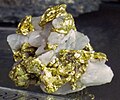Datei:Gold (Saw Tooth Mountains, near Salt Lake City, Utah, USA) (17207409151).jpg

Originaldatei (1.258 × 1.047 Pixel, Dateigröße: 1,01 MB, MIME-Typ: image/jpeg)
![]()
Diese Datei und die Informationen unter dem roten Trennstrich werden aus dem zentralen Medienarchiv Wikimedia Commons eingebunden.
Beschreibung
| BeschreibungGold (Saw Tooth Mountains, near Salt Lake City, Utah, USA) (17207409151).jpg |
Gold and quartz from Utah, USA. (SDSMT 1073, South Dakota School of Mines and Technology Museum of Geology, Rapid City, South Dakota, USA) A mineral is a naturally-occurring, solid, inorganic, crystalline substrance having a fairly definite chemical composition and having fairly definite physical properties. At its simplest, a mineral is a naturally-occurring solid chemical. Currently, there are over 4900 named and described minerals - about 200 of them are common and about 20 of them are very common. Mineral classification is based on anion chemistry. Major categories of minerals are: elements, sulfides, oxides, halides, carbonates, sulfates, phosphates, and silicates. Elements are fundamental substances of matter - matter that is composed of the same types of atoms. At present, 118 elements are known (four of them are still unnamed). Of these, 98 occur naturally on Earth (hydrogen to californium). Most of these occur in rocks & minerals, although some occur in very small, trace amounts. Only some elements occur in their native elemental state as minerals. To find a native element in nature, it must be relatively non-reactive and there must be some concentration process. Metallic, semimetallic (metalloid), and nonmetallic elements are known in their native state as minerals. Gold (Au) is the most prestigious metal known, but it's not the most valuable. Gold is the only metal that has a deep, rich, metallic yellow color. Almost all other metals are silvery-colored. Gold is very rare in crustal rocks - it averages about 5 ppb (parts per billion). Where gold has been concentrated, it occurs as wires, dendritic crystals, twisted sheets, octahedral crystals, and variably-shaped nuggets. It most commonly occurs in hydrothermal quartz veins, disseminated in some contact- & hydrothermal-metamorphic rocks, and in placer deposits. Placers are concentrations of heavy minerals in stream gravels or in cracks on bedrock-floored streams. Gold has a high specific gravity (about 19), so it easily accumulates in placer deposits. Its high density allows prospectors to readily collect placer gold by panning. In addition to its high density, gold has a high melting point (over 1000º C). Gold is also relatively soft - about 2.5 to 3 on the Mohs Hardness Scale. The use of pure gold or high-purity gold in jewelry is not desirable as it easily gets scratched. The addition of other metals to gold to increase the hardness also alters the unique color of gold. Gold jewelry made & sold in America doesn’t have the gorgeous rich color of high-purity gold. Locality: Saw Tooth Mountains, near Salt Lake City, Utah, USA |
| Datum | |
| Quelle | Gold (Saw Tooth Mountains, near Salt Lake City, Utah, USA) |
| Urheber | James St. John |
Lizenz
- Dieses Werk darf von dir
- verbreitet werden – vervielfältigt, verbreitet und öffentlich zugänglich gemacht werden
- neu zusammengestellt werden – abgewandelt und bearbeitet werden
- Zu den folgenden Bedingungen:
- Namensnennung – Du musst angemessene Urheber- und Rechteangaben machen, einen Link zur Lizenz beifügen und angeben, ob Änderungen vorgenommen wurden. Diese Angaben dürfen in jeder angemessenen Art und Weise gemacht werden, allerdings nicht so, dass der Eindruck entsteht, der Lizenzgeber unterstütze gerade dich oder deine Nutzung besonders.
| Diese Bilddatei wurde ursprünglich auf Flickr durch jsj1771 in https://www.flickr.com/photos/47445767@N05/17207409151 hochgeladen. Sie wurde am 3. Mai 2015 durch den FlickreviewR-Bot geprüft und die Lizenzierung der Datei unter den Bedingungen von cc-by-2.0 wurde bestätigt. |
3. Mai 2015
Kurzbeschreibungen
In dieser Datei abgebildete Objekte
Motiv
Einige Werte ohne einen Wikidata-Eintrag
19. August 2010
Canon PowerShot D10 Englisch
0.16666666666666666666 Sekunde
4,9
18,6 Millimeter
320
Dateiversionen
Klicke auf einen Zeitpunkt, um diese Version zu laden.
| Version vom | Vorschaubild | Maße | Benutzer | Kommentar | |
|---|---|---|---|---|---|
| aktuell | 22:50, 3. Mai 2015 |  | 1.258 × 1.047 (1,01 MB) | Natuur12 | Transferred from Flickr via Flickr2Commons |
Dateiverwendung
Die folgende Seite verwendet diese Datei:
Globale Dateiverwendung
Die nachfolgenden anderen Wikis verwenden diese Datei:
- Verwendung auf es.wikipedia.org
Metadaten
Diese Datei enthält weitere Informationen (beispielsweise Exif-Metadaten), die in der Regel von der Digitalkamera oder dem verwendeten Scanner stammen. Durch nachträgliche Bearbeitung der Originaldatei können einige Details verändert worden sein.
| Hersteller | Canon |
|---|---|
| Modell | Canon PowerShot D10 |
| Belichtungsdauer | 1/6 Sekunden (0,16666666666667) |
| Blende | f/4,9 |
| Film- oder Sensorempfindlichkeit (ISO) | 320 |
| Erfassungszeitpunkt | 13:04, 19. Aug. 2010 |
| Brennweite | 18,6 mm |
| Kameraausrichtung | Normal |
| Horizontale Auflösung | 180 dpi |
| Vertikale Auflösung | 180 dpi |
| Software | Adobe Photoshop Elements 13.0 (Macintosh) |
| Speicherzeitpunkt | 00:43, 20. Apr. 2015 |
| Y- und C-Positionierung | Zentriert |
| Exif-Version | 2.21 |
| Digitalisierungszeitpunkt | 13:04, 19. Aug. 2010 |
| Bedeutung einzelner Komponenten |
|
| APEX-Belichtungszeitwert | 2,5849625024037 |
| APEX-Blendenwert | 4,5855635130041 |
| Belichtungsvorgabe | 0 |
| Größte Blende | 4,5855635130041 APEX (f/4,9) |
| Messverfahren | Muster |
| Blitz | kein Blitz, Blitz abgeschaltet |
| unterstützte Flashpix-Version | 1 |
| Farbraum | sRGB |
| Sensorauflösung horizontal | 16.460,905405405 |
| Sensorauflösung vertikal | 16.483,516483516 |
| Einheit der Sensorauflösung | Zoll |
| Messmethode | Ein-Chip-Farbsensor |
| Quelle der Datei | Digitale Standbildkamera |
| Benutzerdefinierte Bildverarbeitung | Standard |
| Belichtungsmodus | Automatische Belichtung |
| Weißabgleich | Automatisch |
| Digitalzoom | 1 |
| Aufnahmeart | Standard |
| Verwendetes Objektiv | 6.2-18.6 mm |
| Datum, zu dem die Metadaten letztmalig geändert wurden | 20:43, 19. Apr. 2015 |
| Eindeutige Kennung des ursprünglichen Dokuments | 9F121BA2F36D45951EB63D33F7CD19B6 |